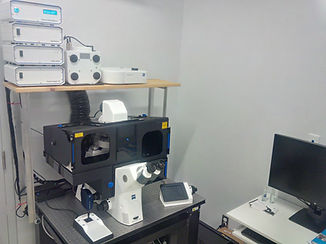top of page

THE LAB
OUR RESEARCH INSTITUTE


Centre Armand-Frappier Santé Biotechnologie
• The Armand Frappier Health & Biotechnology (AFSB) Research Centre contributes to Canadian research
efforts, graduate and postgraduate training, and
technology transfer in the fields of human, animal,
and environmental health.
• The AFSB is one of four Canadian research centres
that constitute the one-of-a-kind Research University
that is the INRS (Institut National de la
Recherche Scientifique). The four INRS research
centres are:
(i) Armand Frappier Health and Biotechnology
Research Centre
(ii) Water, Earth, and Environment Research Centre
(iii) Energy, Materials, and Telecommunications
Research Centre
(iv) Urbanization, Culture, and Society Research
Centre
• The AFSB is home to 48 professors, carrying out
research in three main areas:
(i) Microbiology & Biotechnology
(ii) Infectious Diseases, Immunity, Cancer &
Epidemiology
(iii) Environmental Toxicology & Chemical
Pharmacology

Click below to check out our Institute and the research done here...
OUR LABORATORY

The Islam Laboratory is located on the 3rd floor of the new Laval Biotechnology Development Centre (i.e. Building 70) on the INRS — Armand Frappier Health & Biotechnology Research Centre campus.
OUR EQUIPMENT
Olympus SZX16 Fluorescence Stereoscope
• Cubes for GFP and mCherry fluorescence
• 0.5X and 2.0X objective lenses (3.5X to 230X total
magnification range)
• Base with Bright-Field, Dark-Field, and Oblique
sample illumination
• UC90 4K colour camera (9 megapixel)
• Olympus cellSens software


ZEISS Axio Observer 7 Fluorescence Microscope
• 2.5X, 5X, 40X, and 100X high magnification &
resolution phase and fluorescence objectives
• 63X reflection interference contrast imaging (RICM)
objective
• Apotome optical sectioning for out-of-focus light
rejection
• Colibri 7 fluorescence illuminator (5 discrete LEDs)
• 12 megapixel CCD camera
• Motorized XYZ stage
• ZEN software suite

BMG Labtech Nephelostar Nephelometer
• Laser-based microplate reader
• Measures forward-scattered light when a laser is
directed through the mixture
• ~30X more sensitive than traditional plate readers
that analyze light transmission through the sample
• Can be used for microbial growth and aggregation
testing, as well as turbidity measurements, drug
solubility screening, and protein binding kinetics
• Suitable for to 24, 48, 96, and 384-well microplates
OUR COLLABORATIONS
We are fortunate to have fruitful and ongoing collaborations with the following groups that help us to pursue the most in-depth answers to our various research questions. Thank you everybody! (listed in alphabetical order)
• Chatenet laboratory, INRS—Institut Armand-Frappier (Laval, QC, Canada)
• Ehrlicher laboratory, McGill University (Montreal, QC, Canada)
• Garza laboratory, Syracuse University (Syracuse, NY, USA)
• Gauthier laboratory, INRS—Institut Armand-Frappier (Laval, QC, Canada)
• Mignot laboratory, CNRS—Laboratory of Bacterial Chemistry (Marseille, France)
• Shaevitz laboratory, Princeton University (Princeton, NJ, USA)
• Singer laboratory, University of California, Davis (Davis, CA, USA)
• Sharma laboratory, Institute of Bioinformatics and Applied Biotechnology
(Electronic City, Bengaluru, India)
• Théodoly laboratory, CNRS—Adhesion and Inflammation Lab (Marseille, France)
• Vinogradov laboratory, National Research Council (Ottawa, ON, Canada)
OUR FUNDING SOURCES



_original.jpg)
bottom of page





